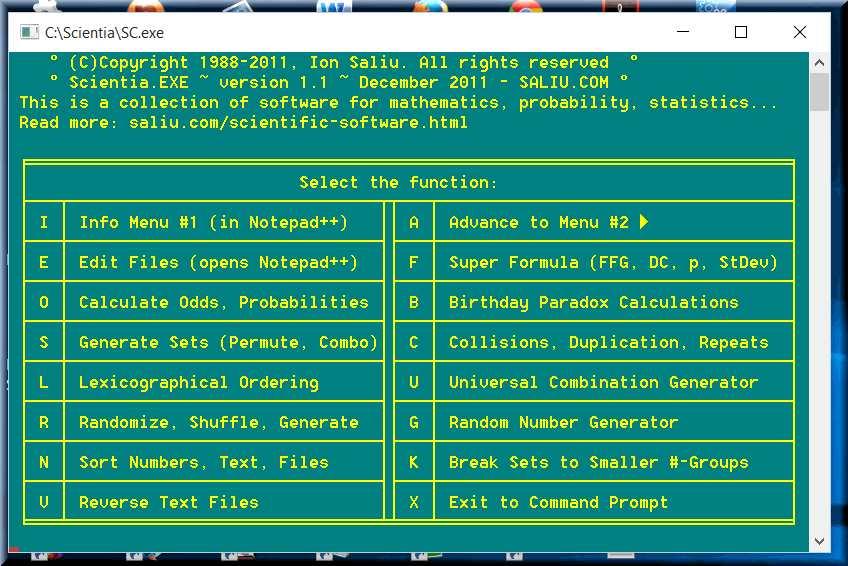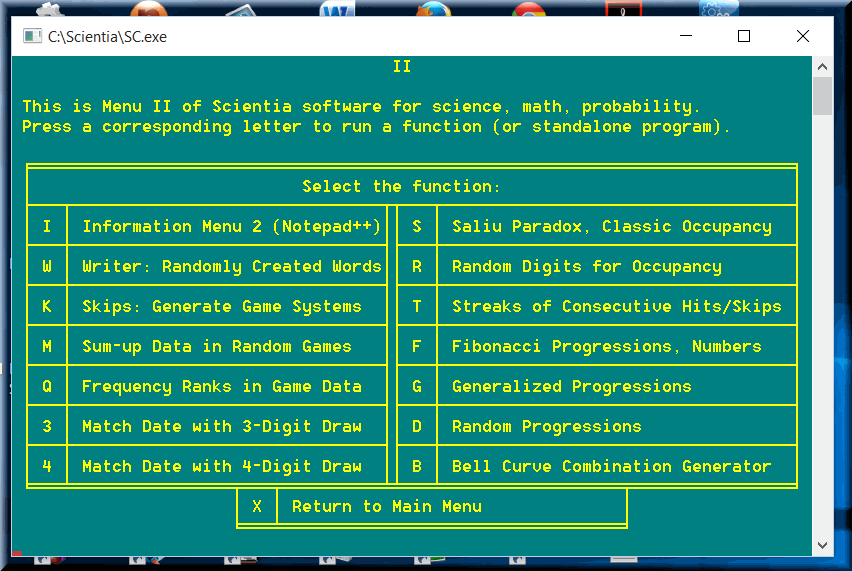


Written by Ion Saliu on April 11, 2011.
• Scientia ~ version 1.0 ~ April 2011 ~ free-to-run scientific software for registered members.
First, you need to become a registered member of this Web site (for a reasonable membership fee). You can download the software from your dedicated membership pages. The membership pages have also clear instructions on downloading, installing, and running the software.
It is also recommended to visit and read all the valuable information on the main software site. Scientia belongs to software category 5.6.

Let's look at the two menus and their applications and functions.

* Option 'F = Super Formula (FFG, DC, p, StDev)'
SuperFormula is the definitive software for statistics, probability, odds, gambling mathematics ... and much more. The functions are grouped in 12 categories. Each software category has its own detailed sub-categories. This unique application grew from the request by many people to create software to automate the calculations in the Fundamental Formula of Gambling (FFG). FFG discovered the most fundamental elements of theory of probability and also the Universe: The relation between the degree of certainty (DC), probability p, and number of trials N.
Program name: SuperFormula.
For more info, read:
* Option 'B = Birthday Paradox Calculations'
* Option 'C = Collisions, Duplication, Repetition'
This is the most accurate and comprehensive software for calculations in the probability of duplication (or collisions, or coincidences, or repetition), including the tiny Birthday Paradox. The software performs the calculations both ways:
1) Calculate the probability (degree of certainty) when the number of persons (elements) is known;
2) Calculate the number of persons (elements) when the probability is known.
Program names: Collisions, BirthdayParadox.
For more info, read:
* Option 'O = Calculate Odds, Probabilities'
The probability software calculates all the ODDS of any lotto game, including Powerball/Mega Millions and Euromillions games. For example, the odds of a lotto-49 game drawing 6 numbers: '0 of 6'; '1 of 6'; '2 of 6'; '3 of 6'; '4 of 6'; '5 of 6'; '6 of 6'. The probability is calculated as EXACTLY and AT LEAST 'M of N'.
The 'Generalized' option calculates the odds for any two-in-one lotto games, including Powerball, Mega Millions, and Euromillions. The 'Horseracing' option calculates the odds for exactas (top 2 finishers), trifectas (top 3 finishers), superfectas (top 4 finishers), etc. The horse racing odds are calculated also as STRAIGHT and BOXED.
Program name: OddsCalc.
For more info, read:
* Some of the programs in this menu represent GENERAL-PURPOSE lottery and gambling software.
* Option 'S = Generate All Types of Sets: Exponents, Permutations, Arrangements, Combinations'
This software generates ALL possible types of sets: Exponents, permutations, arrangements, combinations - and Powerball, Mega Millions, Euromillions combinations. The software generates the sets in lexicographical order or randomly. The sets can be numerical or be composed of words.
An example of exponents (N=3, M=3): 111,112,113,121,122,123,131,132, etc.
An example of permutations (N=3): 123, 132, 213, 231, 312, 321.
An example of arrangements (N=3, M=2): 12, 13, 21, 23, 31, 32.
An example of combinations (N=3, M=2): 12, 13, 23.
Program name: PermuteCombine.
For more info, read:
* Option 'L = Lexicographical Ordering'
The program finds the lexicographical order (index or rank) of a given set and conversely finds the set for a specified index (rank, or numeral, or lexicographic order). Applicable to these set types: Exponents, permutations, arrangements, combinations, Powerball (5+1), and Euromillions (5+2) combinations.
Program name: LexicographicSets.
For more info, read:
* Option 'R = Shuffle or Randomize Elements'
Shuffle lottery combination files (text files); then go to the line equal to the probability median (FFG = 50%). The program can also shuffle numbers in a highly randomized manner. There is a plethora of randomization functions in this program! The program can generate lotto combinations that mimic the official lottery drawings. Included are modules for Powerball, Mega Millions, Euromillions.
Program name: Shuffle.
For more info, read:
* Option 'G = Random Number Generator'
This program generates combinations of random numbers - N taken M at a time; e.g. 49 lotto numbers, 6 per line. There are 2 options:
* combinations or numbers sorted in ascending order;
** arrangements or unsorted numbers — like real-life lottery drawings.
Program name: RandomNumbers.
For more info, read:
* Option 'U = Universal Combination Generator'
Lotto software generates combinations for absolutely any type of lotto game, plus horseracing straight sets. Specifically to this program, the combinations can be generated in steps. That is, the user has the choice to generate lotto combinations with constant gaps or skips between them. For example, starting at the very top of a combination set (the lexicographical order #1), then step 90, the following combination generated will have lexicographic order #91,…, and so on, to the very last combination in the lotto set.
Most certainly, no other lotto program can generate lotto combinations in steps. Furthermore, this incredible lotto software even generates lotto combinations within a range of numbers, or between any lexicographic order indexes (ranks).
Program name: Combinations.
For more info, read:
* Option 'K = Break Sets to Smaller Number-Groups'
Takes one or more lines consisting of numbers and breaks down each line into smaller number-groups: from 1-number groups to groups of 7 numbers per
combination (line). For example, a line with 5 or more numbers can be broken into unique (no-repeat): single numbers, 2-number groups (pairs), 3-number groups (triples), 4-number groups (quads), and 5-number groups (quintets).
Program name: BreakDownNumbers.
For more info, read:
* Option 'N = Sort Numbers, Text, Files, Columns'
Sort your lotto files in ASCENDING order (both horizontally and vertically, by multiple columns).
This function is a great utility in conjunction with the data files. The numbers in every combination (line) in a lotto data file must be sorted in ascending order. The pick lottery files are not sorted in ascending order horizontally -- they are only nicely formatted.
Program name: Sorting.
* Option 'V = Reverse Text Files'
The program reverses the order in text files: the bottom becomes the top. Useful in arranging the lottery data files in the order required by LotWon lottery software. Uncooperative lottery sites publish lottery histories (drawings, results) in an unnatural order: The most recent drawing goes to the bottom, instead of the TOP. LotWon lottery software requires starting with the most recent draw, and go all the way down to the oldest drawing in that lottery game (bottom of file).
Program name: UpDown.
For more info, read:

* Option 'W = Writer: Randomly Created Words, Sentences'
The software randomly takes letters from those 26 of the Latin alphabet via the English extension (W, Y, K). This one-of-a-kind program then combines the letters into words and sentences at random.
Any meaningful text? Not so fast! A dry-wit Brit (probably in an act of jealousy), Thomas Huxley, bet that a monkey hitting randomly the keys of a typewriter would be able to re-write the great works of Great Will Shakespeare. They had no clue about randomness and the Ion Saliu sets (or exponential sets)!
Program name: Writer.
For more info, read:
* Option 'S = Ion Saliu's Paradox, Classical Occupancy Problem'
The software simulates 'Ion Saliu's Paradox of N Trials'. The player selects, for example, the 10-number case; the number of trials N = 10 in this case. The program generates randomly 10 numbers from 1 to 10. Each run of 10 trials will show also how many numbers are missing (numbers NOT drawn in a run of 10 trials). At the end, the program calculates the average of unique numbers per run. That value always tends to {1 — 1/e}. For double-zero roulette, the average of unique numbers in 38 spins is between 24 and 25 for a majority of cases.
2) 'The Classical Occupancy Problem'
a) There are N elements in a set; e.g. the 10 digits from 0 to 9. The program generates the numbers randomly until all have appeared;
b) The program can also calculate various probabilities related to the classical occupancy; e.g. the degree of certainty that all 10 digits from 0 to 9 will be randomly drawn in 30 trials. The calculations are based on the degree of certainty (DC) of the Fundamental Formula of Gambling (FFG).
Program name: OccupancySaliuParadox.
For more info, read:
* Option 'R = Random Digits for Classical Occupancy'
This program simulates "The Classical Occupancy Problem". The program simulates a wide range of games, from coin tossing, dice throwing, 10 digits, 3-digit combinations of the pick-3 lottery, etc.
Program name: RandomDigits.
For more info, read:
* Option 'T = Streaks of Consecutive Hits and Skips'
The software calculates the number of like-streaks in a number of trials. For example: how many streaks of exactly 5 consecutive heads in 1000 coin tosses?
Program name: Streaks.
For more info, read:
* Option 'F = Fibonacci Progressions, Terms, Numbers, PHI'
This program generates Fibonacci numbers and calculates the golden ratio PHI between two consecutive terms of the Fibonacci series.
Program name: Fibonacci.
For more info, read:
* Option 'G = Generalized Progressions (including Fibonacci)'
The software generates progressions from type 1 to type P. A type 1 progression is the power of 2 series or Martingale. The type 2 progression is known as the famous Fibonacci series. To generalize, a type P progression is a series of numbers where the Nth term is the sum of the preceding P terms.
Program name: Progressions.
For more info, read:
* Option 'D = Random Progressions'
This program generates random progressions, calculates the ratio between two consecutive terms of a random series, and compares that ratio to the roots of the golden proportion.
Program name: RandomProgression.
For more info, read:
* Option 'Q = Rank Lottery Numbers by Frequency'
This program generates frequency reports two ways: 1.- Regardless of position; 2.- Position by position. The lotto numbers are ranked by frequency in descending order, from hot, to mild, to cold.
Program name: FrequencyRank.
For more info, read:
* Option 'M = Sum-up Lottery Data Files and Games'
The program calculates the number of lottery combinations that add-up to a sum-total. It also calculates the sums of each draw in lottery files, plus root sum, and standard deviation. You can generate such lottery combinations and save them. The program creates summary reports for the game: Every sum-total and its amount of combinations, plus percentages.
Program name: Sums.
For more info, read:
* Option 'K = Create Lotto, Lottery, and Gambling Systems'
This program creates lottery and gambling systems based on two or three consecutive skips; the most recent skips make it into the system.
Program name: SkipSystem.
For more info, read:
* Option 'B = Generate Combinations inside FFG Median Bell'
This software generates combinations in the FFG median zone and inside the bell (Gauss) curve. The program can be used for: pick-3 4 lotteries, horse racing, lotto-5, -6, -7, Powerball, Mega Millions '5+1', Euromillions '5+2', roulette, sports betting, and soccer pools.
Program name: BellCurveGenerator.
For more info, read:
* Option '3 = Match Date with Pick-3 Drawing'
* Option '4 = Match Date with Pick-4 Drawing'
This type of software simulates random pick-3 or 4 combinations for each day of the year, in a continuous cycle. Then the software checks if a combination is equal to its corresponding date in the American format.
Inspired by the New York Lottery drawing 9,1,1 on September 11, 2002 (date expressed as 9/11 or 09/11).
Program names: DatePick3, DatePick4.
For more info, read:

Home | Search | New Writings | Fundamental Formula | Odds, Generator | Contents | Forums | Sitemap
